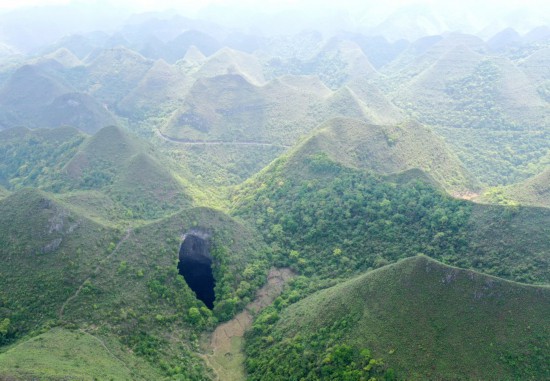Giant karst sinkhole discovered in China's Guangxi

Aerial Photo taken on April 19, 2020 shows a Tiankeng, or giant karst sinkhole, at Leye-Fengshan Global Geopark, south China's Guangxi Zhuang Autonomous Region. (Xinhua/Zhou Hua)
NANNING, May 7 (Xinhua) -- A cave exploration team has discovered a giant karst sinkhole in Leye County, south China's Guangxi Zhuang Autonomous Region, bringing Leye's number of such sinkholes to 30.
Zhang Yuanhai, a senior engineer with the Institute of Karst Geology of China Geological Survey, said the sinkhole, located near Ping'e village under Luoxi township, measures 306 m in length, 150 m in width and 192 m in depth, with its volume exceeding 5 million cubic meters, and can be categorized as a large sinkhole.
Zhang said that there are three big caves in the wall, which are presumed to be the remains of the early evolution of the sinkhole. The bottom of the sinkhole has a well-preserved primitive forest.
Chen Lixin, leader of the Guangxi 702 cave expedition team, said the ancient trees growing at the bottom are nearly 40 meters high, and the dense shade plants are up to one's shoulders.
The expedition was completed on Friday, after the team members abseiled down more than 100 meters and trekked several hours to reach the pit's bottom. They returned to the ground safely on Friday evening.
Giant sinkholes, also known as Tiankeng (heavenly pit) in Chinese, are dolines, or giant pits, with special geological features found in karst regions formed by repeated cave-ins. They are mainly found in China, Mexico and Papua New Guinea.
Photos
Related Stories
- Glass platform affords visitors view of 613-meter-deep sinkhole in Guangxi
- Scenery along Yulong River in S China's Guangxi
- Scenery of paddy fields in south China's Guangxi
- Tunnel under construction on Guiyang-Nanning high-speed railway in Guangxi
- Farmers harvest tea leaves in Shanglin, Guangxi
- Blooming Matsutake mushrooms usher in harvest season in S China's Guangxi
- 14 COVID-19 patients in China's Guangxi recover, leave hospital
- Citizens view plum blossoms in Qingxiu Mountain scenic area in Nanning, S China's Guangxi
- GDP of China's Guangxi up 7.5 pct in 2021
- Staff members conduct disinfection work on train in Nanning, Guangxi
Copyright © 2022 People's Daily Online. All Rights Reserved.










